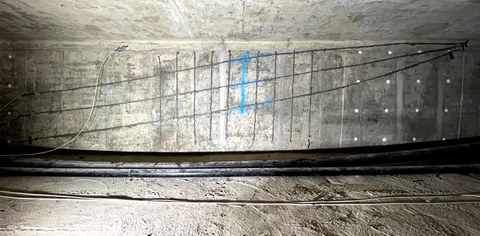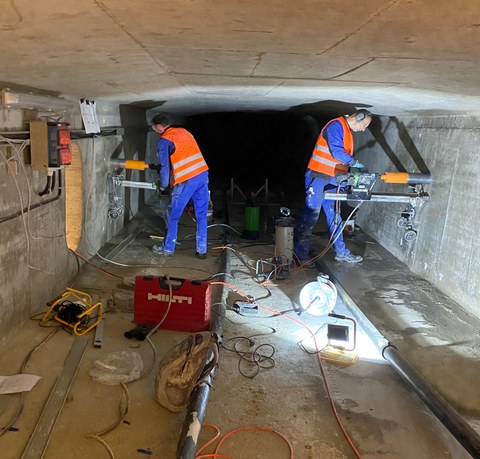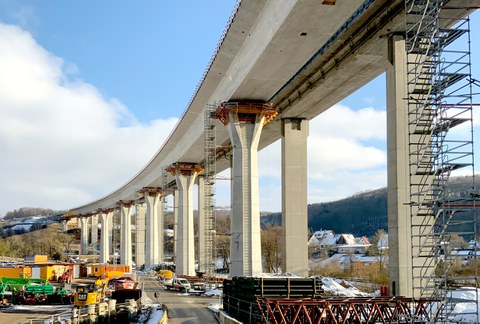Material investigations at the Unterrieden viaduct
Table of contents
Project data
| Titel | Title Erfahrungssammlung für den Brückenrückbau durch Materialuntersuchungen an der Talbrücke Unterrieden | Gathering experience for bridge dismantling through material investigations at the Unterrieden viaduct Auftraggeber | Client MKP GmbH, Weimar (gefördert durch die Autobahn GmbH des Bundes, Niederlassung Nordbayern, Nürnberg) Zeitraum | Period Seit 06/2022 Wissenschaflicher Projektleiter | Scientific project leader Prof. Dr.-Ing. Steffen Marx Team IMB | Team IMB Dipl.-Ing. Peter Betz, Dipl.-Ing. Daniel Gebauer, Raúl Beltrán M.Sc., Max Herbers M.Sc. Team OML | Team OML Dipl.-Ing. Kathrin Dietz, Dipl.-Ing. (FH) Sabine Liebelt, René Wallschläger, Bernd Wehner, Andreas Thieme, Doreen Sonntag, Tino Jänke, Heiko Wachtel, Martin Findeisen, Michael Liebe Projektpartner | Project partners MKP GmbH, Weimar | Adam Hörnig Baugesellschaft mbH & Co. KG, Aschaffenburg |
Report 2023
Do viaducts have multiple personalities?

Fiber-optic sensors attached to a bridge web for strain measurement during drilling through the tendons
Bridge structures are demolished for a variety of reasons. Overloading is often the cause of damage, but material-specific issues, such as the use of prestressing steels susceptible to stress corrosion cracking, can also be a factor. To accurately assess the structure during dismantling, knowledge of the relevant material parameters is essential. Uncertainties can be reduced through as-built investigations. However, dismantling is generally time-consuming and costly. When dismantling in the direction of bridge erection, tendons are cut away from the coupler joints, requiring temporary re-anchoring of the tendons via bond mechanisms. In addition to the tendon properties, the tensile strength of the concrete is particularly important in preventing splitting crack failure.
During the dismantling of the Unterrieden viaduct, extensive material analyses were conducted. These analyses can serve as a basis for more efficient planning of subsequent dismantling projects and for a planned bridge deconstruction guideline. A total of 141 drill cores were taken for 108 compression and 33 splitting tensile tests. The tests enabled the assessment of concrete uniformity across multiple construction phases and revealed significant strength reserves compared to the expected values in the as-built documents. In the future, concepts for optimizing the required scope of sampling will be developed, along with non-destructive sampling of the structure.
Bond tests were conducted on specimens from the structure to confirm the assumptions made in the demolition design regarding the bond properties, which were based on literature research on similar tendons. To better assess the anchoring behavior of the tendons in the component after severing, additional fiber-optic sensors were applied to the web surface in the area of the severing points. These sensors run along the tendon axes and in vertical loops to provide a picture of the strain conditions over as large an area as possible.
Report 2022
Material investigations during dismantling

Drill core extraction in the hollow box of the existing structure
Due to arithmetic deficits in the assessment of existing bridge structures, many bridges are currently being replaced by new structures. This is always accompanied by the dismantling of existing structures, for which no regulated verification concepts exist considering the various stages of deconstruction. In addition, there is often a lack of information on the actual condition of the structure, which is why the planning of the deconstruction has to be based on existing documents and assumptions. In order to avoid these uncertainties, it is advisable to carry out investigations for a more realistic assessment of the structure.
One of these deconstruction measures concerns the Unterrieden viaduct, a bridge on the highway BAB A 6 between Nuremberg and Amberg. It is a prestressed concrete superstructure typical for the 1960s. During the construction of the bridge, prestressing steel susceptible to stress corrosion cracking was used, which is why the load-bearing capacity of the structure could no longer be guaranteed. Within a research project accompanying the deconstruction, our aim is to optimise the planning for existing structures and, in particular, for the deconstruction by means of extensive as-built investigations.
As an essential part of the investigations, we will compare different methods for recording the as-built geometry, e.g. laser scanning and photogrammetry, with regard to the effort and the quality of the data-based models obtained. Furthermore, the concrete properties are examined in detail using different testing methods. On the one hand, drill cores are taken destructively. In addition, non-destructive methods are used. Ultrasonic run times and rebound hammer values are recorded which we’ll analyse with regard to their correlation to the results of the drilling cores. This database should enable us to make recommendations for a statistically validated scope of investigation. Another main focus is on the subsequent anchorage of cut tendons. The prerequisite for this is, on the one hand, a sufficient grouting of the tendons and, on the other hand, the concrete must be able to absorb the transverse tensile stresses that occur.
The systematic evaluation and analysis of the described investigations form an important basis for the regulations in a dismantling guideline to be developed.
Short description

Unterrieden viaduct during incremental launching of the new superstructure (left) next to the old one (right)
The deconstruction of viaducts poses a multitude of problems, the solution of which often has no normative basis. In the context of the dismantling of the Unterrieden viaduct, a prestressed concrete structure typical of the 1960s, extensive as-built investigations are therefore being carried out, scientifically evaluated and assessed with regard to the optimization of as-built and, in particular, dismantling plans. An essential part of the investigations is the testing of various methods for recording existing geometries and the determination of material properties in order to be able to make initial recommendations for a simplified procedure for future experimental verification methods. Furthermore, the focus is on the assessment of the subsequent anchorage of tendons that are cut through in the course of deconstruction. The investigations thus form an important basis for future deconstruction planning and regulations to be developed.
